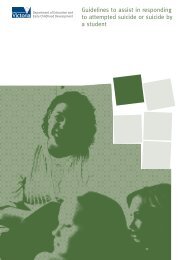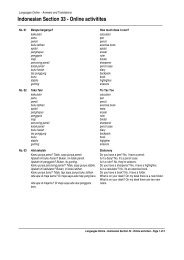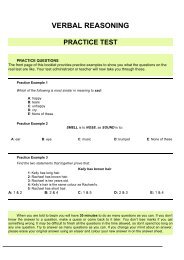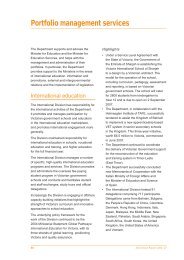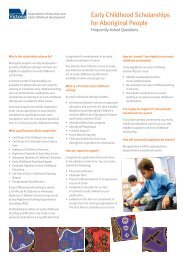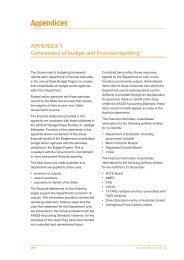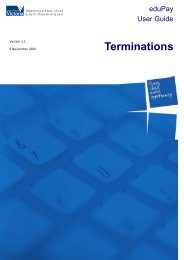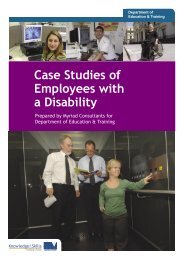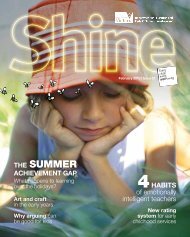November 2009 Vol. 1, Issue 10 (PDF - 16.2Mb) - Department of ...
November 2009 Vol. 1, Issue 10 (PDF - 16.2Mb) - Department of ...
November 2009 Vol. 1, Issue 10 (PDF - 16.2Mb) - Department of ...
You also want an ePaper? Increase the reach of your titles
YUMPU automatically turns print PDFs into web optimized ePapers that Google loves.
Distance Education Centre<br />
celebrates a century<br />
For the last <strong>10</strong>0 years, the old Correspondence School has been helping students from Victoria’s<br />
most remote corners to overcome the tyranny <strong>of</strong> distance, writes Jennifer Cameron<br />
Hospital visitor Beverley Shearer checks<br />
over six-year-old patient Gary’s work, 1966<br />
Each school is a small community: a village<br />
where we nurture and educate the young,<br />
and send them out into the world to find<br />
their place within other communities.<br />
Distance Education Centre Victoria<br />
(DECV) – formerly the Correspondence<br />
School – is also a community, which, from<br />
the outside, appears to be student-free.<br />
There is no evidence <strong>of</strong> uniforms, teachers<br />
on yard-duty, ringing bells, raised voices or<br />
childish behaviour.<br />
Actually, DECV is home to 150 staff who<br />
look after more than 3000 students ranging<br />
from Prep to VCE. Principal Bronwyn<br />
Stubbs oversees a staff with a hierarchy<br />
similar to that <strong>of</strong> mainstream schools, with<br />
assistant principals, KLA leaders, year level<br />
coordinators, and welfare and support staff.<br />
Our large campus is set beside the Darebin<br />
Creek in Thornbury. We even deliver a<br />
curriculum for practical subjects, including<br />
art, music, physical education and dance.<br />
I came to DECV after teaching for many<br />
years in a mainstream high school, with<br />
little knowledge <strong>of</strong> the school’s history. I was<br />
certainly unaware that I was walking into its<br />
centenary year. Little did I know, that <strong>10</strong>0<br />
years ago, trainee teachers from remote country<br />
schools who could not come to Melbourne for<br />
evening and weekend classes did their training<br />
by correspondence. In May 1914, Mrs Mabel<br />
Prewett, living in a remote logging settlement<br />
in the Otways, wrote to the Victorian<br />
Education <strong>Department</strong> seeking help with the<br />
education <strong>of</strong> her children, and so began the<br />
correspondence school for primary children.<br />
During 1916–1917,<br />
returned soldiers<br />
participated in<br />
teacher training by<br />
correspondence,<br />
which would assist<br />
them to integrate<br />
back into the<br />
community.<br />
By 1922, the<br />
Victorian Correspondence<br />
School was <strong>of</strong>fering correspondence<br />
at the Secondary level.<br />
Today, DECV caters for Victorian students<br />
who are travelling within Australia or living<br />
overseas or are unable to attend their local<br />
school for a variety <strong>of</strong> reasons. Some attend<br />
their local high school, but do not have<br />
access to subjects <strong>of</strong> their choice. We also<br />
provide education for elite sports students<br />
from the Australian Institute <strong>of</strong> Sport, young<br />
Olympians in training, ballet students,<br />
prisoners, and students involved in the arts<br />
such Gabrielle Cilmi, the pop singer.<br />
A young boy at his desk in a makeshift<br />
room on his family’s remote property.<br />
A family’s house-bus parked near<br />
Killarney in southwest Victoria, 1970s.<br />
John Nelson broadcasting on S/W Radio<br />
VL3RT. On the wall is a mao covering<br />
some <strong>of</strong> the routes being travelled by<br />
the school’s itinerant families.



